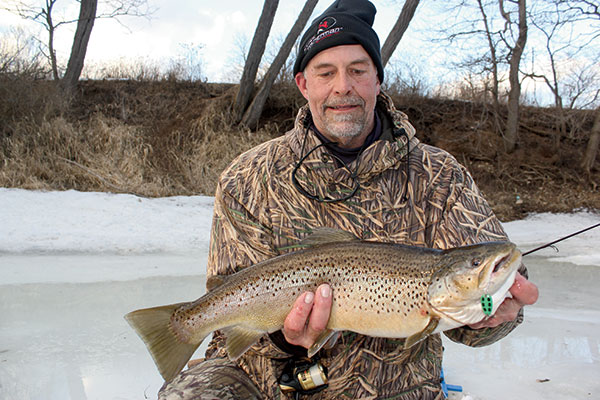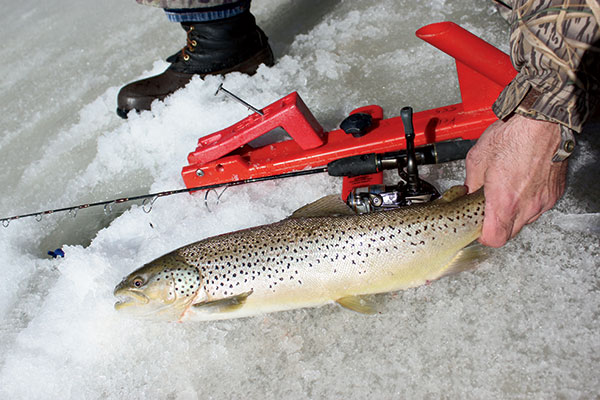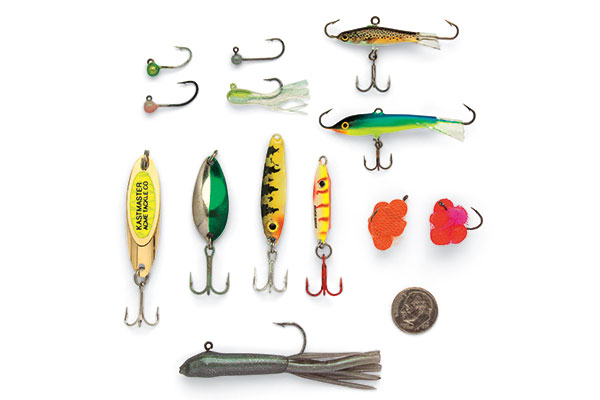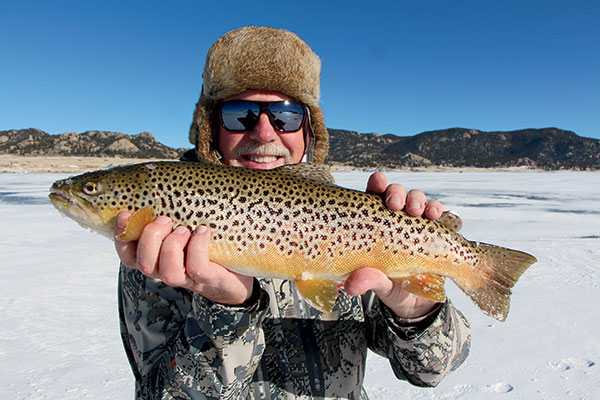Ice Tactics for Bulging Brown Trout
By Matt Straw

Walking on a frozen river is something I ordinarily won't do. But I've been known to follow "cheese-head" friends out on farm-country rivers in Wisconsin. "Follow" is the operant word, and only when the targets are brown trout the size of basset hounds.
So I show up a little late, after all the holes were drilled by Kerry Paulson, inventor and owner of Automatic Fisherman. Paulson likes to hunt browns everywhere, but this day we were on a river. "Even in slow rivers, browns look for current breaks under the ice," Paulson says. "Deeper water has to be nearby, but active browns often use areas only 3 to 4 feet deep, sometimes even shallower. They hang in the tailouts of pools where they find a current void under the flow running overhead."
Location
Location is about finding the least current over the right substrates. "Huge brown trout come out of Lake Michigan in fall and many stay in the river all winter," he says. "In Milwaukee Harbor, some people say browns like structure, some say they like flats. But it's a different game in harbors and lakes. In rivers, steelhead hold around rocks while browns prefer a softer bottom. Look along the shore.

"Rocky shorelines predict steel; grass and sand predict browns. They travel that corridor more. Big ones hold on bottom more than steelhead, so I fish 2 to 6 inches off bottom. For steelhead, we set baits halfway down. Browns are lazier. Steelhead hang on the edge of the current or on the outside of a bend. Browns often hold on shallower inside bends, on sand- or mudflats next to the edge of the ice in one foot of water at times—literally a foot or two from the bank—often just downstream of a creek, spring, or freshet."
Rigging Up
I like a #6 Owner Mosquito Hook with no weight on the line in slack water and lakes, but a 1/64- to 1/32-ounce TC Tackle or VooDoo Custom Jig anchors a spawn bag, piece of shrimp, or several waxworms in current. I prefer 6-pound Seaguar AbrazX Fluorocarbon, but Paulson wants more stretch. "I like 6-pound mono," Paulson says. "I've caught monsters with 6-pound Trilene XL; friends have taken browns up to 29 pounds with it."
Spawn is the most consistent bait for Paulson. "Hardcore anglers favor brown trout, coho, or salmon spawn from early ice through midwinter because that's what browns feed on after those species spawn," he says. "I primarily use steelhead spawn and it works all winter. I think the key is fresh bait, not eggs from specific species. Shrimp is something a lot of people overlook. But some experts don't leave the house without it. And what we call Play-Doh—Berkley Gulp! dough in jars rolled into balls—catches everything. But when you harvest a ripe female steelhead from a put-and-take fishery and tie spawn bags with that, it catches browns anywhere."
Tactics
In shallow water, browns know when you're overhead no matter how quiet you are. So we stand or sit well away from a trap line of Automatic Fishermans placed in key spots. When fish bite, the rod tip snaps up and the arm it was supporting clacks down on the frame. If the drag is set right, you can reach the rod before the fish topples the rig. "Stand where you don't want the fish to travel," Paulson advises. "Stand, walk or sit well away from the holes. Light coming down the holes is a huge factor. Use hole covers or snow to block light. It's especially important on Lake Superior during the middle of the day."
Paulson has fished the Apostle Islands area of Superior many times with Guide Aron Kastern (Unlimited Trophy Outfitters, Mason, Wisconsin). "Brown trout fishing is the bulk of our winter business," Kastern says. "We have two types of browns. German and Scottish strains run up rivers in fall to spawn and then funnel back out. Some winter in the streams, some along shorelines under the ice. In the lake, Seeforellens and St. Croix strains can be around wood in 4 feet of water or out suspended over depths of 100 feet. At first ice, usually around Christmas time, we look for browns on structure. They might be on the first break down to 8 or 10 feet of water or on the second break down to 30, 40, or even 50 feet along a shipping channel or typical steep Superior shoreline."
River mouths can be key, but Kastern avoids community holes. Beyond that, likely-looking habitat stretches for miles. The intersection of rocky breaks and softer flats is a key location. "Finding them is tricky," he says. "We look for spots where rocky structure comes close to soft-bottom flats. Browns are versatile feeders. They root out crayfish and take sculpins off bottom, yet sometimes they suspend under lake herring over deep water. Looking down the hole, you see them come through in pairs or groups right under the ice at times. They're all over the place, so we set pretty high for them in clear water. If they're hungry and close to the bottom, browns come zipping up to bite."

Cold as she is, Superior grows stupendous browns. "The average fish is 20 to 24 inches," Kastern says. "But we don't get too excited until they get up to 30 inches. A 34-incher is a great fish on a short rod. We use the Automatic Fishermans with 8-pound test because you have no idea what size fish you hook. We sometimes walk around hole-to-hole and jig, but we always have some tip-ups or Automatic Fishermans set. When fishing shallow, you have to keep quiet. Set lines out and sit down. It's typical to find them in 8 to 10 feet, and they're spooky at those depths."
Kastern's clients catch browns on Acme Little Cleos and Kastmasters from 1/8 to 1/2 ounce, depending on depth. "Jigging Raps, marabou jigs—browns can be taken on a variety of lures," he says. "If they're shallow on a bug bite, we catch them on spawn bags and light line. Sometimes we pursue them in 50 feet of water with lipless cranks—whatever efficiently covers the necessary depths. All these tactics appeal to incidental steelhead, splake, and cohos, too. Last year was a really good year. Every year seems to be getting a little better."
It seems that brown trout in inland lakes and reservoirs behave in similar fashion. Robby Richardson, an Eagle Claw pro-staffer in Colorado, fishes Blue Mesa Reservoir, one of Colorado's largest waters. "It has a healthy population of brown trout and ice fishing is one of my favorite ways to target them," he says. "Average fish are 1 to 2 pounds with a decent number in the 3- to 4-pound range. Occasionally we ice a 10-pounder. The key to consistently finding browns in Blue Mesa is finding food adjacent to rock structure of some sort, whether a sunken island or a riprap shoreline. Current from a nearby inlet is a plus. Depth varies through the season from 10 to 60 feet. Low-light periods are typically best, but we typically find browns moving up to feed all day long."
Huge lakers also inhabit Blue Mesa. "To be prepared for anything, I fish a medium-power rod in the 28- to 32-inch range for most presentations," he says. "I'm a fan of Wright & McGill Tony Roach ice rods because the bite can be extremely light. I use a 500- to 1000-size Shimano Sedona reel with 10-pound PowerPro or 6-pound Yo-Zuri Hybrid line, depending on the temperature and whether I'll be fishing outside or inside. I use 6-pound P-Line Fluorocarbon leaders with braided mainline because browns are spooky and have great vision."

Richardson catches browns with a variety of techniques. "Two of the most productive are jigging spoons or jigging and deadsticking with plastics," he says. "My favorites are the DX Lures Flutter Spoons, Acme Kastmasters, Northland Buck-Shot Spoons, and Rapala Jigging Raps. Most of the time I work them aggressively to get the browns' attention, then slow down to twitches and nods when fish approach. If perch are in the area, banging bottom or working within a few feet of bottom is effective. I tip lures with a mealworm, waxworm, earthworm, a piece of perch, or some sucker meat.
"For plastics, I primarily use 1- to 3-inch tubes in brown, white, glow, and perch colors to match natural forage," Richardson adds. "Sometimes playing keep-away or subtle jigging works, but a deadsticked tube suspended or set right on the bottom makes things easy for less aggressive fish. This technique usually requires a rod tip indicator or slipbobber. Bites can be incredibly subtle."
Some of Richardson's biggest browns appear when he targets yellow perch. "When I have a camera down, I often see a perch school scatter. Not long after, a brown trout zips in, kicks up sediment, and either eats a perch or my presentation," he says. "That's brown fishing in a nutshell in our neck of the woods."
Clack. The trigger arm falls against the frame of an Automatic Fisherman. Heads snap in that direction. A rod thrashes in the holder like a thing alive. We all run.
*In-Fisherman Field Editor Matt Straw, Brainerd, Minnesota, is an avid trout and salmon angler, pursuing them in all seasons.

